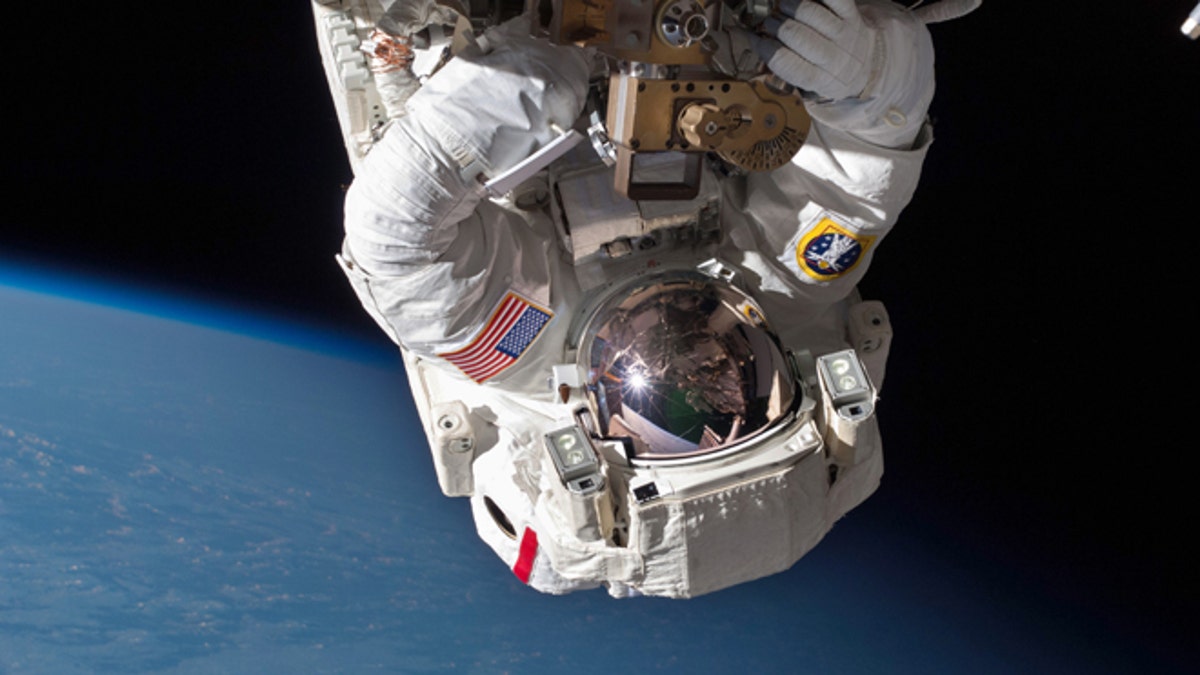
Astronaut Chris Cassidy performs a space walk to inspect and replace a pump controller box on the International Space Station after an ammonia coolant leak was discovered in May, 2013. (AP Photo/NASA)
CAPE CANAVERAL, Fla. – After a spacewalking astronaut nearly drowned in his helmet in July, NASA has a plan to protect its crew when they venture into the vacuum of space this weekend: snorkels and absorbent towels.
NASA has determined that as many as four urgent spacewalks are necessary to fix a broken cooling line that led to the shutdown of several systems at the International Space Station, the space agency said during a press conference Wednesday afternoon. Station managers decided to send two American astronauts out as soon as possible to replace a pump with a bad valve.
The catch: Italian astronaut Luca Parmitano nearly drowned in July, when more than a gallon of water leaked into his helmet, filling it like a fishbowl. Should water start pooling up again, NASA says it will be ready -- thanks to a hack worthy of TV's "MacGyver."
[pullquote]
“Some smart engineers on the ground said, hey, this looks like a snorkel you’d use for scuba diving,” explained Allison Bolinger, NASA's lead U.S. spacewalk officer. NASA realized that a water-line vent tube could be snipped down and attached with Velcro within the spacesuit, between a water restraint valve and the astronaut, she explained.
- Earth from above: 10 best images from 40 years of Landsat
- 2013’s top 20 images of planet Earth
- Walking with dinosaurs: Feathered, furry and fierce
- Google Glass wink feature makes sneaking photos even easier
- Top 5 tech gifts for teenagers
- The $6,000 Santa Stakeout Kit
- Delta Air Lines won’t allow voice calls in flight, cites objections of frequent fliers
The crew members themselves fabricated the snorkels on Sunday.
“This is your last resort … if water is in your suit you can lean down and use this to breathe,” Bolinger said.
The space agency also installed absorptive pads in the back of each helmet, which will soak up any water that shows up like a sponge. The spacewalkers have been trained to tilt their heads back periodically to test the pad, she said; if it sucks up around 6 and a half ounces of water, it will feel “squishy” -- a sure sign of trouble.
“That’s a sign there is a problem in the EMU and it’s time to come inside,” Bolinger said.
The absorptive pads were designed on the ground and shipped up to the space station in a recent cargo craft. But while waiting for their arrival, NASA’s engineers looked at other ways to MacGyver towels from material on board the space station: space diapers.
“We look at ways to modify the maximum absorption garment that the astronauts wear, but that created a lot of [mess],” Bolinger said.
The solutions sound makeshift but the situation is real, though the faulty pump is far from life-threatening. Astronaut Rick Mastracchio said last week that the station's navigation, lights, toilet and other vital systems still work. The failed cooling unit is largely affecting the astronauts ability to do science aboard the orbiting space base, explained Dina Contella, ISS flight director.
The space station cooling system, which runs ammonia through the lines, is critical for dispelling heat generated by on-board equipment -- mainly science projects at present.
“The pump is actually running, but can’t integrate with internal water loop,” Contella said. “We’re running cold, that’s the issue. We want to be able to close the valve and we can’t do it.”
When half of the station's cooling system shut down last Wednesday, it forced the six-man crew to turn off all nonessential equipment, including some science experiments. Because of the valve failure, one of the two cooling lines became too cold.
While the astronauts are safe and comfortable, NASA wants the system back up to full strength, in case of another failure that could leave the orbiting outpost even more vulnerable than it is right now.
Flight controllers tried in vain to fix the valve remotely, then came up with a plan to use another valve to regulate the temperature. Some success was reported, and for a while, engineers thought the space station could limp along with the short-term solution. Instead managers have opted for spacewalks right now.
“it’ll take about three [spacewalks], it could be less if we get lucky … or more if we’re not lucky,” said Mike Suffredini, International Space Station program manager.
This is the same pump that was replaced by a pair of spacewalking astronauts in 2010, although different things malfunctioned at the time -- that was the pump itself, now it’s just a valve. But three spacewalks were needed then as well.
Mastracchio and astronaut Michael Hopkins trained for just such a repair before rocketing into orbit. They have been prepping all week, just in case of just such a decision.
The potential risk of a flooded space helmet is very real, however; in fact, Mike Hopkins will be wearing the very same suit that nearly flooded on spacewalker Parmitano. NASA has scrubbed the suit, added new parts to it, notably a fan pump separator, and considers it as good as a brand new one.
“We think that’s an extremely clean suit and it's ready to go,” Bolinger said. “We have high confidence that it’s essentially just like a unit that was refurbished on the ground.”
Orbital Sciences Corp., meanwhile, will stand down from its planned Thursday night launch of its Cygnus cargo ship from Wallops Island, Va.
The station crew includes three Russians and one Japanese, aside from the two Americans.
